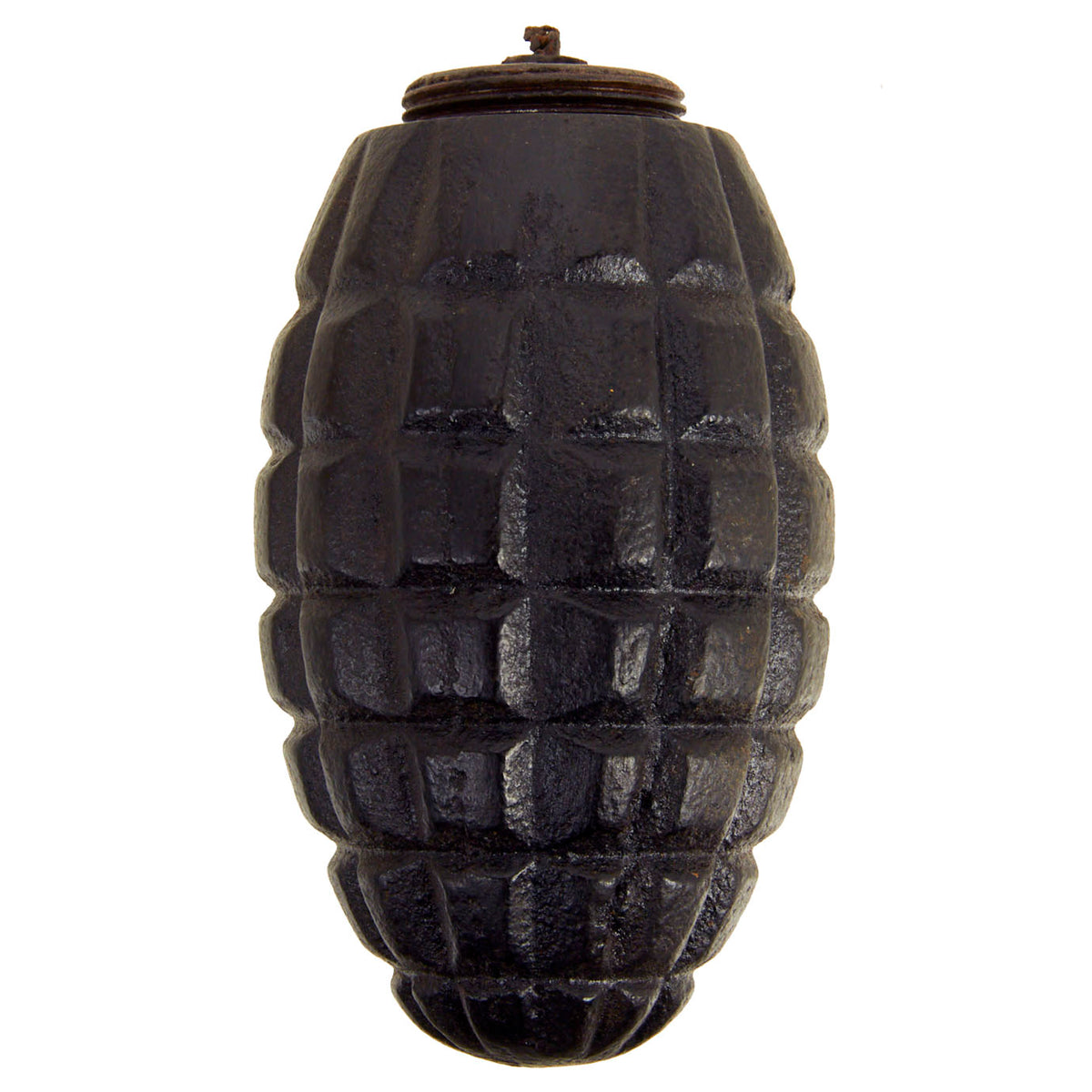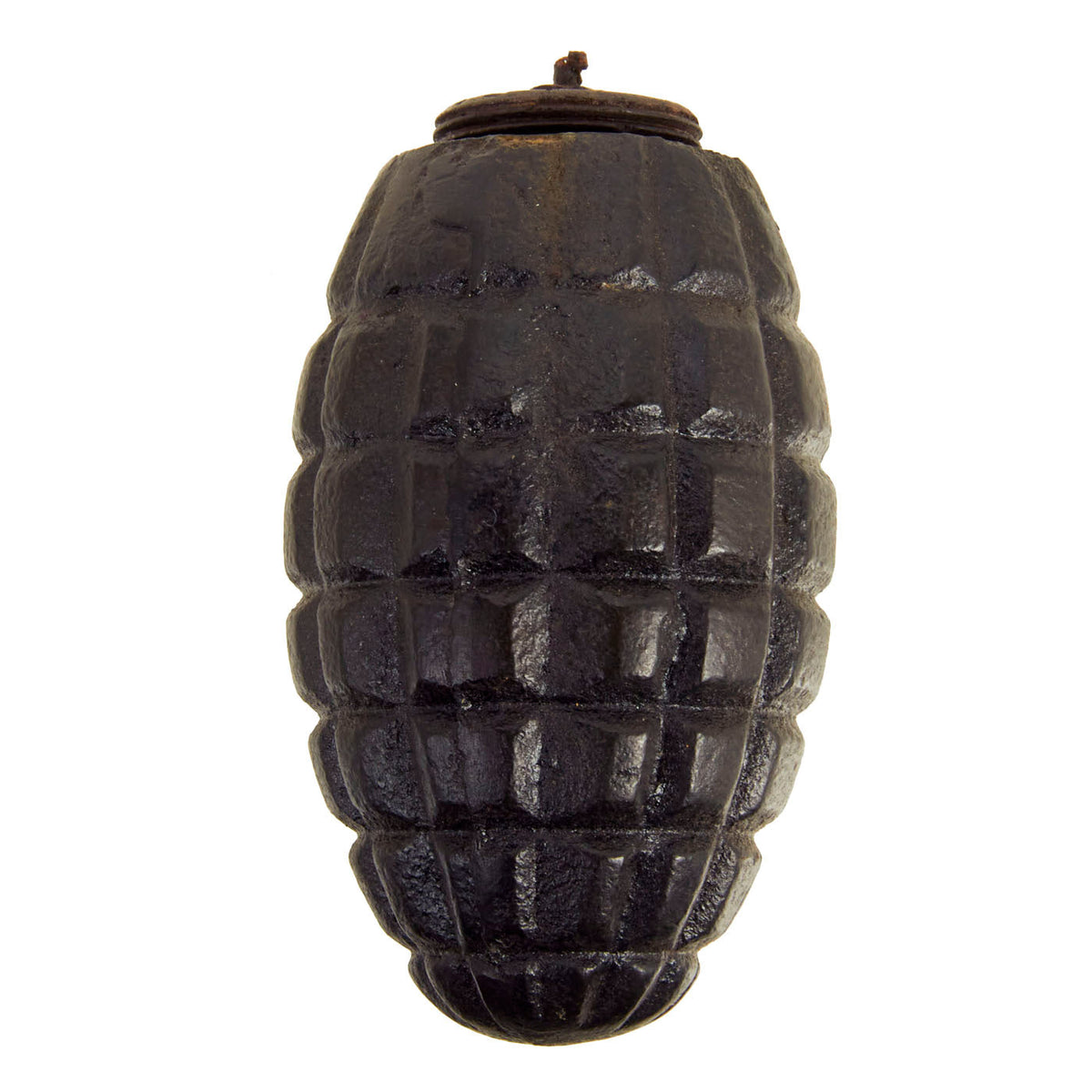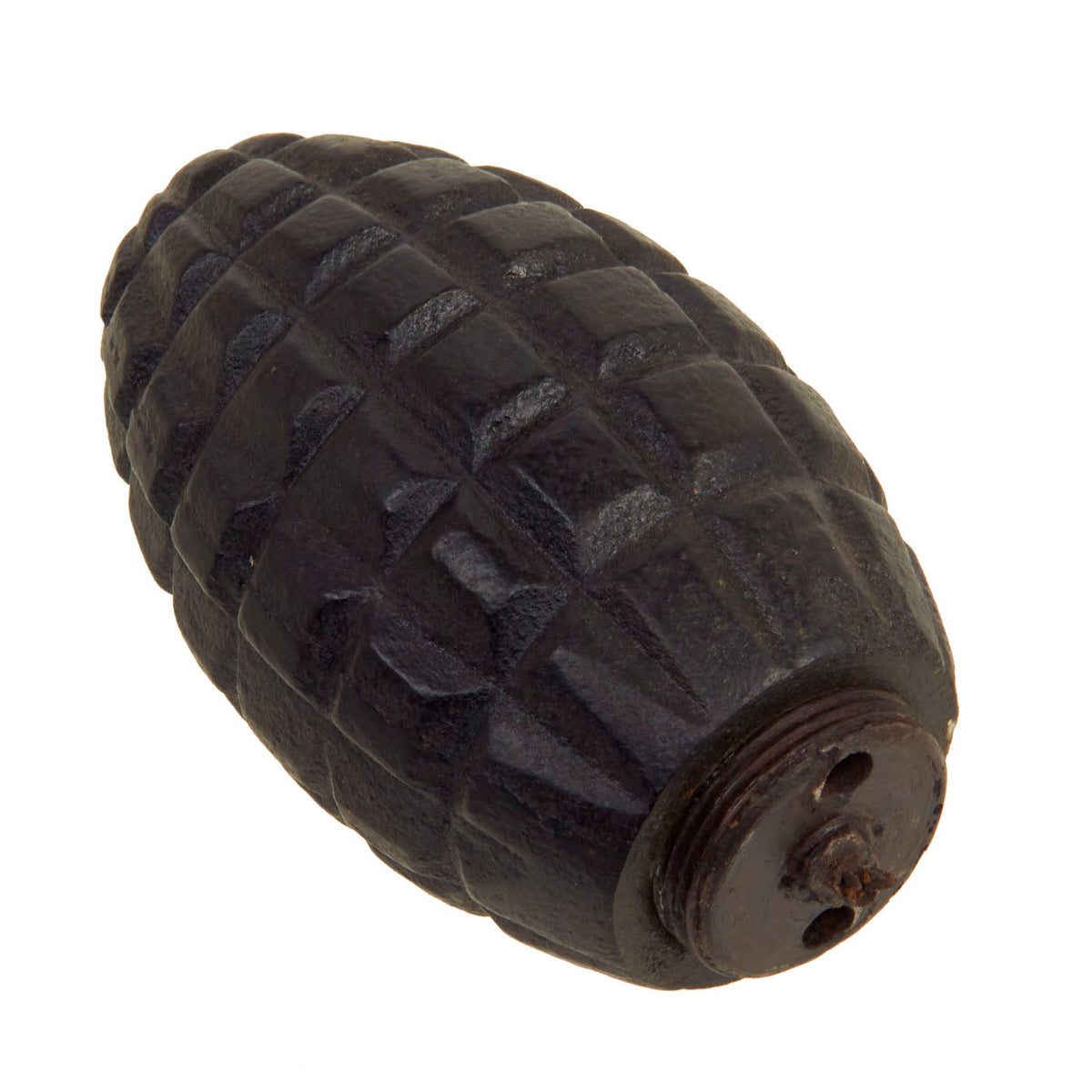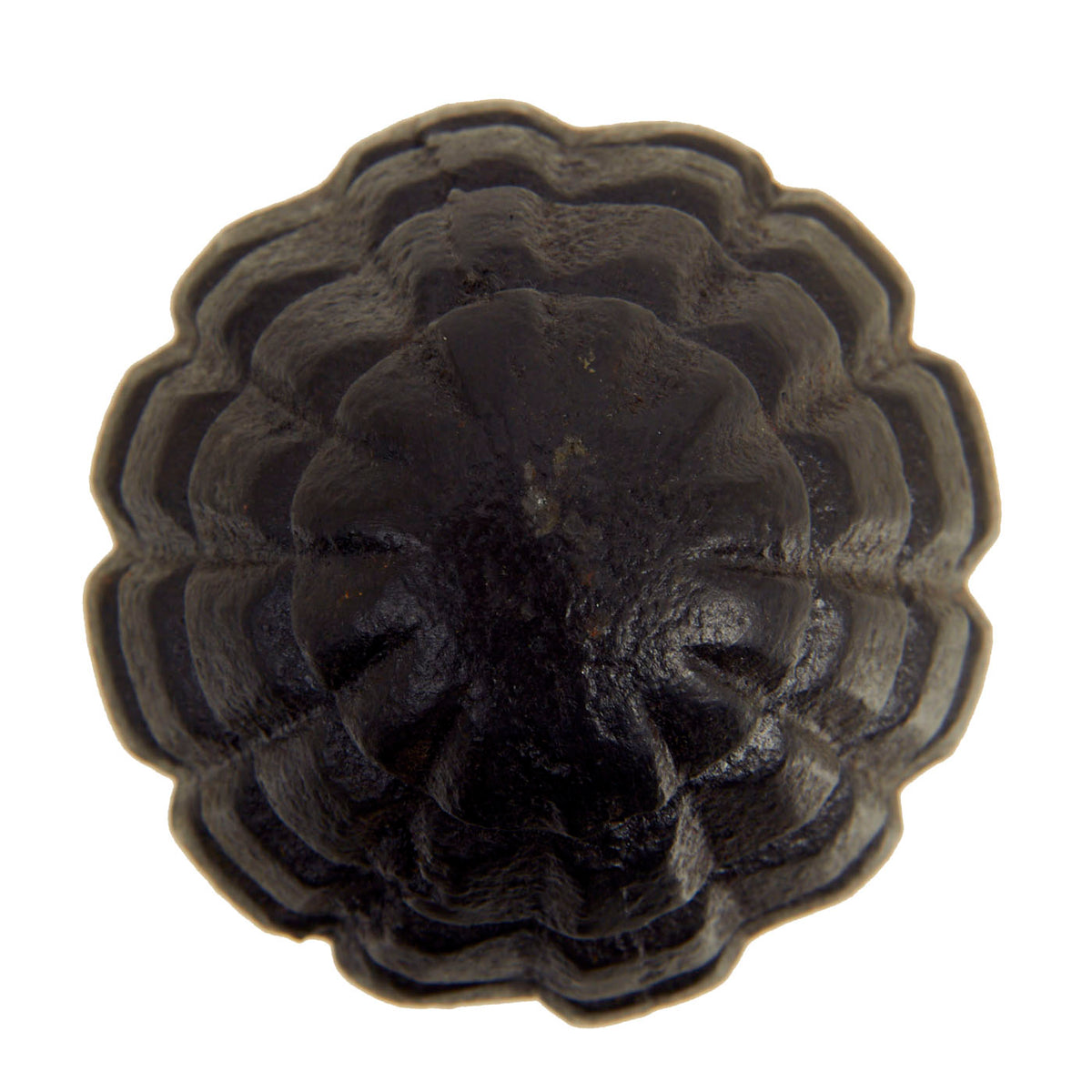Original Austro-Hungarian WWI Inert Heavy Schweregranate Hand Grenade Original Items
$ 325,00 $ 97,50
Original Item: Only One Available. This is a totally inert example of a “heavy” Schwere hand grenade, as used by Austro-Hungarians during the later years of the Great War. This grenade is completely void of any explosive content with an inert fuse as per the BATF guidelines on inert ordnance. This cannot be converted back to be used as an explosive device.
Not Available For Export
Schwere hand grenades were made of cast-iron and were produced in quite a number of different styles and sizes. All models were used by Austro-Hungarian forces throughout the war.
This Austrian Schwergranate or Schwerhandgranate, which literally translates to “heavy hand grenade”. As the name implies it is quite heavy and large, measuring about 5 inches tall and 2 3/8 inches across at the widest point. It features a standard fragmentation pattern on the body, and a top fuse, which originally would be covered by the nearly impossible to find wooden cap. The fuse assembly also unscrews from the body to show the interior explosives cavity.
There is not much information on these, but there appears to have been 2 patterns made, and we believe that this is the second, with a more elongated body. It can also stand on end, unlike the first pattern with the rounded bottom.
This is one of a few examples we have seen, and it is in great shape, with lots of the original exterior finish, and only a bit of rust on the fuze area.
This is a must have in any WWI or ordnance collection! These are very difficult to come by, don’t miss your chance!
In World War I, hand grenades were also known as “hand bombs.” The general philosophy for their use in the fighting armies was that grenades could kill the enemy underground or behind cover. They could also force the enemy into the open, providing targets for rifle and machine gun fire.
Offensive grenades used concussion, or shock-waves, to wound, while defensive grenades exploded, scattering shell fragments. Gas, smoke and illuminating grenades were also used in World War I. These grenades were made of brass, iron and steel, some with handles of wood and even cardboard. They went by many names: Battye bombs, Citron Foug, Newton-Pippin, Petard, Besozzi, Kugel, Cigaro and Sigwart; and took on many shapes.
The term “grenade” comes from the Latin, granatus, literally “filled with grain.” The “grain” in grenades was explosive mixtures and compounds contained in metal canisters and set off by spark, fuse, mechanical or percussion ignition. Some sources relate that the term is derived from the Spanish word granada or pomegranate, for the resemblance between the fruit and the weapon. When grenades first came into use in warfare is unknown. But legend has it that the first grenade was a small box of live vipers (snakes) which ancient warriors threw into the enemy’s camp.
The first recorded use of the word “grenade” came in 1536, from the siege of Arles in southern France by French forces under King Francis I. The early grenades were made of glass globes, jars, kegs and firepots. A 1665 reference related that grenades were carried in a pocket called a grena-diere.
By 1667, the French army had regular companies of grenadiers. Grenades did not play a large part in warfare, although the French used some 3,200 of them at Sebastopol in 1854-55, and got some Russian ones in return. Some were used in the American Civil War, but they came into prominence in the Russo-Japanese war, just a decade prior to WWI. The Russians established three factories in Port Arthur, China to turn out a thousand grenades a day.
On that fateful day of June 28, 1914, when the Austro-Hungarian Archduke Franz Ferdinand and his wife Sophie were assassinated, several of the Black Hand conspirators carried and used Kragujevac hand bombs, named for the Serbian army depot. Their explosions caused a verbal explosion from the Archduke Franz Ferdinand to the Mayor of Sarajevo after early attempts on his life “What is the use of your speeches? I come here to pay you a visit, and I am greeted with bombs. It is outrageous!”
Fast Shipping with Professional Packaging
Thanks to our longstanding association with UPS FedEx DHL, and other major international carriers, we are able to provide a range of shipping options. Our warehouse staff is expertly trained and will wrap your products according to our exact and precise specifications. Prior to shipping, your goods will be thoroughly examined and securely secured. We ship to thousands clients each day across multiple countries. This shows how we're dedicated to be the largest retailer on the internet. Warehouses and distribution centres can be located throughout Europe as well as the USA.
Note: Orders with more than one item will be assigned a processing date depending on the item.
Before shipping before shipping, we'll conduct a thorough inspection of the items you have ordered. Today, the majority of orders will be delivered within 48 hours. The delivery time will be between 3-7 days.
Returns
The stock is dynamic and we cannot completely manage it because multiple stakeholders are involved, including our factory and warehouse. So the actual stock may alter at any time. It's possible that you may not receive your order once the order has been made.
Our policy is valid for a period of 30 days. If you don't receive the product within 30 days, we are not able to issue a refund or an exchange.
You can only return an item if it is unused and in the same state as the day you received it. You must have the item in its original packaging.
Related products
Uncategorized
Uncategorized
Uncategorized
Uncategorized
Uncategorized
Uncategorized
Uncategorized
Uncategorized
Uncategorized
Armoured Fighting Vehicles of the World: AFVs of World War One (Hardcover Book) New Made Items
Uncategorized
Uncategorized
Uncategorized
Uncategorized
Uncategorized
Uncategorized
Australian WWII Owen MK1 Machine Carbine SMG Custom Fabricated Replica with Sling Original Items
Uncategorized
Uncategorized
Band of Brothers ORIGINAL GERMAN WWII Le. F.H. 18 10.5cm ARTILLERY PIECE Original Items
Uncategorized












































































